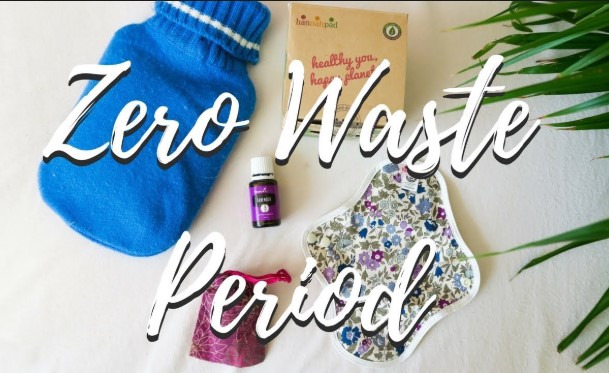I have few regrets, but this is one of them: It’s that I didn’t know about eco-friendly period products until I was in my early 30’s. I know. All those wasted years! Thankfully, I figured it out and made the switch to a menstrual cup and reusable cloth pads.
I’ll give you the rundown on some of my favourite zero-waste period products that you might consider switching to. The good news is that they’re not just good for the environment, but that they’ll also save you money, as well as reduce your exposure to toxic chemicals.
There isn’t much to not love about reusable period products. Let’s get to it!
ZERO WASTE OPTION #1: MENSTRUAL CUPS
First up on our list of zero-waste period products is the menstrual cup. You may have heard of the Diva Cup, Lunette Cup, Mooncup or Lena Cup before? They’re basically bell-shaped devices that you insert into your vagina to collect menstrual fluid and are designed to replace tampons.
Here are a just a few of the reasons why you might consider them over tampons:
- They’re reusable and can last for around 5 years if you take care of them well
- The capacity is 3-4x higher than a jumbo tampon, making them are an obvious choice if you have a heavy period
- Menstrual cups come with a lower risk of Toxic Shock Syndrome, and contain no toxins in them
- You’ll save a ton of money by making the switch. Think thousands over a lifetime!
- Thousands of tampons vs a handful of menstrual cups—it really does make a big difference for our environment
The only real problem with menstrual cups is choosing the right one because there are so many brands, sizes and stem options. However, you can narrow down the choices with a menstrual cup quiz that’ll help you find the right one for your body type.
Check it out here: Find the Perfect Menstrual Cup.
ZERO WASTE OPTION #2: REUSABLE MENSTRUAL PADS
Next up for zero-waste options are cloth pads. They’re similar to disposables but are made from natural materials like cotton, bamboo and charcoal. Like disposables, they come in a wide range of sizes from pantyliners to heavy, overnight pads.
Most people find them very comfortable, although they can get a bit sweaty and sticky sometimes. If you exercise, keep a box of disposable to use for that purpose. In terms of absorbency and preventing leaks? They work great.
But perhaps the best thing about them is that you’re eliminating your exposure to toxic chemicals. This is kind of a game-changer if you have allergies or sensitive skin. Make the switch today and I’m sure that you’ll notice a big difference.
The minor hassle to cloth menstrual pads is that you have to wash them. If you don’t mind some staining, just throw them in with your regular laundry and don’t have a second thought about it. If you do, soak them in cold water after use and you’ll be good to go.
Cloth pads are kind of a game-changer if you want to go plastic free so check them out today.
ZERO WASTE OPTION #3: PERIOD PANTIES
Have your heard of Thinx Period Panties? They’re all over social media and have a huge advertising budget. If you don’t know what they are, Thinx is the most popular brand of absorbent underwear that you can wear during your period.
You can use period panties as a backup to a menstrual cup or tampon, for spotting, light incontinence, or vaginal discharge. They’re comfortable, last as long as regular panties, and are a nice alternative to disposable pantyliners.
The most important thing is to be sure of which kind you’re buying, the ones with only a leak proof layer, or those with absorbent padding. Either one can work fine, but you’ll probably want a specific kind for different purposes.
READY TO GO GREEN?
You won’t regret it. Making the switch to a menstrual cup, cloth pads, or period panties is a great choice not only for the environment, but your bank account balance and health.
Author Bio
Jackie Bolen (http://jackiebolen.com/) is a tree-hugging, friend of the Earth who can usually be found on top of a mountain, paddling the rivers, or drinking coffee around Vancouver, Canada. Her hope is that a reusable period product will one day be found in the hands of every single menstruating person in the world.




